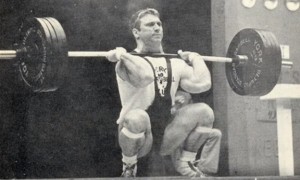I don’t care what anyone says. All of us interested in athletics, health, and fitness have an innate desire to get jacked while retaining a low body fat. The holidays make this challenging. But common coping strategies are cretinous. Hermitting yourself into social exclusion? Maybe. Becoming a glutton from November until February? Don’t think so. [...]
I don’t care what anyone says. All of us interested in athletics, health, and fitness have an innate desire to get jacked while retaining a low body fat. The holidays make this challenging. But common coping strategies are cretinous.
Hermitting yourself into social exclusion? Maybe. Becoming a glutton from November until February? Don’t think so. Using moderation? Hell no.

In the interest of being human, I’m all about enjoying the holiday season and embracing hedonism. But there are things we can do to “minimize the damage.” Last year, Martin Berkhan (my favorite nutritional resource) released an article entitled Cheat Day Strategies for a Hedonist. Devour this article. There is none better.
Can you avoid fat gain during cheat days and holiday feasts like Thanksgiving and Christmas? Sure, you can. But if you’re a big eater that loves food, like me, it’s more a question of minimizing fat storage than attempting to avoid it.
-Martin Berkhan
But from my experience, people drastically alter their training the weeks surrounding holidays. And while Cheat Day Strategies for a Hedonist is a great article, it only deals with the nutritional side of the equation. So let’s look at how to train your way through the holidays.
THE TAO OF THE HOLIDAYS
The week before holiday feasts, you get anxious. Forecasting the unfavorable nutritional choices, you adjust your training and diet. You increase your volume and intensity in the weight room, and start eating less than normal. This is your attempt to lean out so that a few days of binging only brings you back to baseline.
The week of the feasts, the trends continue. But the pressure is mounting. You eat even less and increases your training frequency.
When they begin, you indulge beyond comprehension. You’re cashing in on two weeks of preparation. But between the actual feasts and devouring left overs the following days, you realize that your pre-lean out theory didn’t hold up like you had anticipated.
The following week, you keep your training jacked through the roof with the volume, intensity and frequency increased. To compensate for the holiday blunder, you drop your calories lower than they have ever been.
WHAT YOU DID WRONG
You involuntarily created three intensive weeks of training in an energy and nutrient deprived state. This creates a few problems:
#1: Three Weeks of Wasted Training
Aesthetically, there’s no reason to train if you’re not giving yourself the raw materials needed to support growth. Kelly Baggett tells a story about Larry Scott:
Hell, Larry Scott was one of Vince’s followers and never even bothered to train unless he could take in a pound of milk and egg protein and cream per day in addition to his normal diet. He knew he wouldn’t gain without it so why bother?
#2: Wasting of Adaptation Potential
Training is a stressor that our body adapts to. But when adaptation happens, more stress is needed to expose the body to a new demand. It’s like caffeine sensitivity. One cup of coffee only does the trick for so long. Then you need two cups. A few months later you’re reaching for a third cup.
From a training standpoint, everyone has a ceiling. Jacking up the volume and intensity makes the ceiling higher. It’s like drinking one cup of coffee per day, then suddenly drinking four. It wastes adaptation potential. Since muscular growth isn’t supported on a caloric deficit, the ceiling is being raised with nothing to show for it.
#3: Increasing your risk of injury
Increasing frequency, volume, and intensity within three weeks time is overload. Especially in a nutrient deprived state.
HOW TO MAKE IT BETTER
Jacking up the frequency, intensity, and volume haphazardly won’t get you far. Here are some training strategies to be used in conjunction with Martin Berkhan’s nutritional strategies to help hedonists survive the holiday season.
#1. Don’t Plan Far Ahead
The week before the holiday, keep your regular training and routine in place. Don’t try to “pre-lean out.” You’re going to eat a lot regardless, and you will end up with the same “I ate too much and feel bloated” mentality after it’s over anyway. If anything, planning too far in advanced makes the situation worse because you feel like you need to soak up the glory as much as possible once the feast begins. But keeping your training stable ensures productivity.
#2. Increase the Volume the Week Of
The week of your feasts, jack up the volume by doing 1-5 drop sets of 10-20 for all of your lifts. These need not be overly exhaustive, but get a good pump after your main workouts. This type of training strategy will benefit from the increased carbohydrate and calorie consumption. It gives the body something else to process, especially if you’re not used to doing drop sets. Also, feel free to do as much pump-up isolation work that you want to.
#3. Train the Morning of the Feast
If you’re following Berkhan’s recommendation, you’re going to be pounding down protein. By training in the morning(s) of your feast(s), you’re hoping that whatever nutrients and calories are being consumed can be extracted for use somewhere in the body.
#4. Switch to Total Body Training
If you train the morning of your feast, ideally you want it to consist of the most metabolically exhaustive exercises. Leg based workouts are great, but take it a step further and do a whole-body compound extravaganza. Hit presses, squats, pulls, and chins hard and come back with a non-stop circuit of 1-5 x 10-20 (as discussed in #2). If you celebrate multiple days in a row, then try to duplicate the same workout. If needed, drop 10-20% of your big lifts, but keep the circuit the same. Down some BCAA’s or protein fluff to stave off hunger over and provide some initial sustenance before your holiday meals.
#5. Ditch Exercise for Calories-Sake
Running on the treadmill for an additional 30 minutes isn’t going to do shit. Avoid extra exercise for the sake of “burning calories.” The reason I suggest adding volume (#2) is because it may have some benefit when combined with the high carbohydrate and caloric intake. The idea here is to optimize partitioning, as described by Kelly Baggett:
Partitioning refers to what happens when excess calories are consumed. Are they directed into muscle or fat stores? The worse your partitioning, the more fat you gain when you gain weight. The better your partitioning, the more muscle you gain.
Bottom line here is that you’re going to consume excess calories, no matter how much you jaunt on the treadmill. The goal is to give our bodies some way to use it. So if you’re going to do “extra” work, make sure that it’s something more prone to spur muscular growth (ie: increased volume, bodybuilding pump work, 20 rep breathing squats, etc.)

If you’re OCD and need some kind of metabolic hit, settle for some Front Squat Tabata Intervals as a “finisher” to your workout. I usually never recommend these, but in honor of getting jacked, I’ll let my guard down. They would be a nice fit here.
#5. Deload the Week After
This sounds backwards. Training with a lesser intensity the week after? But that’s when you want to hit the gym hard and undo all of the bad choices you made, right?
Yes, but as explained before, there’s no reason to go to the gym if you aren’t going to nutritionally support it. And, as we know, diet plays a more important role in body composition than training does.
Use the week after your feasts to dial it back in the gym. Reduce overall carbohydrate intake, and let your body come back to a normal state. If you increased the volume and used some of the above training tactics, your body will need time to unwind.
People become frantic after a few days of binging. They think that all of their gains dwindle away in a three day span. But after feasts you feel “fuller” because of bloating, not because an appreciable amount of fat was created. By deloading the week after, you’re giving your body a chance to sort these issues out before assessing the real damage. Bloating settles down once your eating habits return to normal, not training habits. So give yourself a break and reduce your overall volume and workload by half. Don’t strain. Get in, get out, and then eat your vegetables and proteins.
Again, if you have multiple days of holiday eating, start your deload the first day after it ceases. You’ll need it if you trained every morning using a total body scheme with extra volume, and perhaps threw in tabata front squats.

